TG John Limited, the company which became Alvis, was founded by Welshman T.G. John, a naval architect and highly qualified engineer, in 1919. From the start the company was based in the Midlands city of Coventry, already a major centre of motor vehicle manufacture. Early products were stationary and scooter engines, stop-gap products until the first Alvis car appeared early in 1920, based on designs by Geoffrey de Freville, who had earlier been associated with the Bentley brothers. Late in 1921 TG John Ltd. became The Alvis Car & Engineering Co. Ltd. The origin of the name Alvis is obscure, although it seems to have come from de Freville. Key figures in the Alvis story G.T. Smith-Clarke and W.M.Dunn joined the firm in 1922. Smith-Clarke as Chief Engineer and Works Manager, Dunn as Chief Draughtsman.

1929-Alvis Works 1929-T. G. John The Iron Foundry The Machine Shop 1936-Engine Plant TA14 Chassis
Smith-Clarke was responsible for all engineering matters until his retirement from the firm in 1950. He and Dunn kept Alvis at the forefront of technological advancement throughout. T.G. John remained a major shareholder and looked after the financial and business affairs of the company. The market for sporting and luxury cars is at best an uncertain one and Alvis' early history is not without its financial ups and downs. But the directors stuck to their philosophy of making as much of the car as possible on the premises, with their own iron and aluminium foundries and comprehensively equipped machine shops. These factors, allied to sometimes idiosyncratic design features, gives Alvis cars, especially those from the pre-war years, more than their fair share of individuality and character. Despite sometimes being in a financially precarious state, the management team at Alvis were far-sighted, imaginative men and never shrank from investing in experimentation, or, as it is now known, research and development.

1929 FE Front Wheel Drive
Front-wheel drive, all-independent suspension, the all synchromesh gearbox and then independent front suspension were some of the better known developments. All of this activity took place in the Holyhead Road works. The directors foresaw the need to diversify from car production, and moved to aero engine and armoured fighting vehicle production. The first step in this direction came with the purchase of more land on the Holyhead Road, further along from the existing car factory. A new factory for aero engine manufacture was built and a licence for radial engines taken out from Gnome et Rhône of France, but orders proved hard to find. Much development work took place on tanks and armoured cars, and the company title was shortened to Alvis Ltd. in 1936.
George Lanchester worked for Alvis for some years in the late 1930s and was responsible for the design of the 12/70 and Silver Crest cars. Alvis began to develop their own aero engine designs, the famous Leonides making its first flight in early 1939. Alvis made a tremendous contribution to the war effort, much of it sub-contract work on Rolls-Royce aero engines. The car factory was severely damaged in the Luftwaffe raid on Coventry in 1940, but the aero engine factory escaped almost unscathed. Armoured vehicle production was not yet significant.
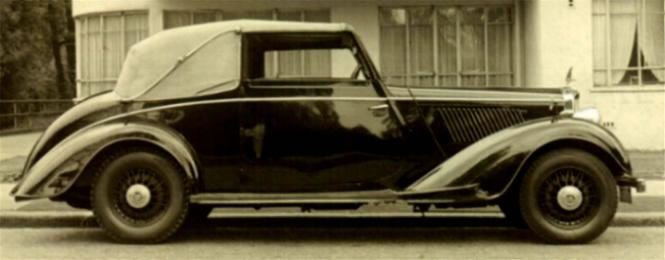
1937 Silver Crest
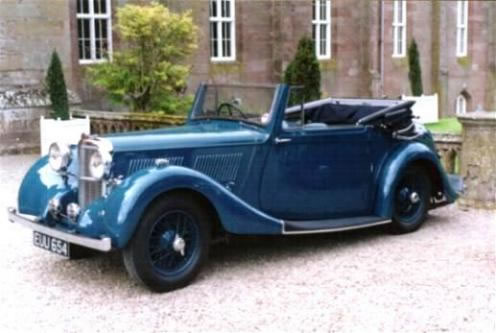
1938 12/70 Mulliner
T.G. John retired in1944 and the bulk of the responsibility for running the company fell upon G.T. Smith-Clarke, W.M. Dunn and A. Varney. Government interference and high taxation levels on expensive cars made the change back to peace-time operation difficult for the company. The TA 14 was put into production, developed from the 12/70, but there were persistent problems with the supply of bodies, something which was to dog Alvis for the remaining years of car production. For a time the firm made printing presses, but the success of the Leonides 9 cylinder radial aero engine assured the future. Helicopters became widely used post-war and many were Leonides powered. The engine proving particularly suitable for this application.
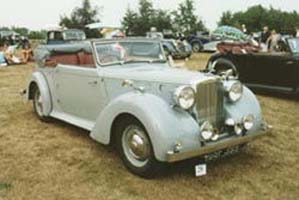
1949 TA14 Carbodies
Later the 14 cylinder Leonides Major was developed. Many drawings of the prewar car designs had been burned during the air raid in 1940, but Alvis' commitment to supporting the owners of already aged Alvis cars never wavered. Owners were asked to supply their worn parts so that new drawings could be produced and newparts made. Meanwhile design of the first wholly new postwar car was in progress. Armoured car production began and J.J. Parkes joined as ManagingDirector. It was soon apparent that car production was only going to be a minor part of the Alvis business in the postwar years and the body supply question really decided the issue. The independent coachbuilders gradually went out of business or were bought over by other manufacturers.
Alvis looked atacquiring their own facility, but the volumes necessary to secure an adequate return on the investment made this unfeasible. It had been proposed to use a body from Pressed Steel on the new Three Litre, but costs ruled this out for the proposed chassis numbers, and in the end a traditional bodies from Mulliners and Tickford were fitted. Significantly some TA14 chassis were exported to Switzerland where three found their way into the hands of Hermann Graber, a top-flight coachbuilder. From 1952 to 1955 Alec Issigonis worked for Alvis, designing an innovative new car with alternate 4 cylinder and V8 engines and rubber suspension conceived by Alex Moulton. Yet again costs prevented realisation of this ingenious design to production. It was a fascinating car and it is greatly regretted that, apparently, no photographs of it exist. By 1955 Mulliners were exclusively contracted to produce bodies for Standard, indeed they were taken over by that firm only a few years later.
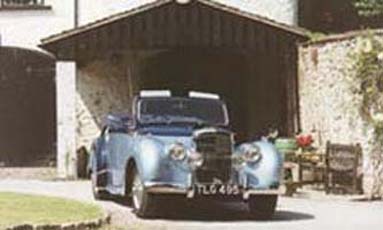
1955 TC21/100 Tickford
The Alvis car division was consistently losing money and had become more or less a public relations exercise and the TC21/100 was looking very dated. Further investment in car production looked unlikely given the success of the other divisions. No-one would have believed that the Three Litre would simply refuse to die and that it had over ten years of production and development life left in it. It was Hermann Graber who came to the rescue. He had been building small numbers of very elegant bodies on Three Litre chassis since the early 1950s for sale to his Swiss customers at high prices. These cars were more or less "one-offs" and were light, strong and modern looking. Alvis hoped that they would be able to have bodies built in series to Graber's design in the UK substantially cheaper than the Swiss articles. Accordingly two cars were sent to Switzerland for prototype bodies to be built, then returned to the UK, complete with the necessary jigs and patterns for series production.
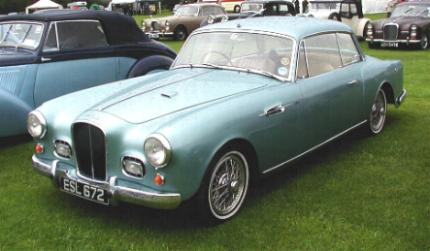
1957 TC108G Graber
A few cars were made. Whilst they were much admired and discussed, they were simply too expensive. The situation was only retrieved by going to the Rolls-Royce subsidiary Mulliner Park Ward to redesign the body to enable its production, suitably modified for the British market and at a lower price. This was achieved in no uncertain manner and the cars sold well. Alvis' independence came to an end in 1965 when the company was taken over by Rover and in turn became part of the British Leyland empire a couple of years later. By now most of the company's production was their highly successful ranges of armoured vehicles. The car division carried on until 1967, along with the Aero Engine department, which had gradually lost ground as more and more aircraft became powered by gas turbine engines.

1963 TD21 Series II
New armoured vehicles were developed, including light tanks with Alvis remaining suppliers of precision engineering products to the aircraft industry. Sold off by British Leyland, Alvis became part of United Scientific Holdings in 1981 and more recently became known as Alvis PLC. In 1990 Alvis left Holyhead Road for a new factory at Walsgrave on the outskirts of Coventry and then in 1999 the link with Coventry was broken when "The Alvis" was moved to Telford, where production continues. In 2004 the company became part of BAe Systems. The Holyhead Road site, where once some of the finest cars and aero engines the world has seen were made by craftsmen who knew no equals, is now a retail development, symbolising the brave new Britain of the 21st century.

Army All Terrain